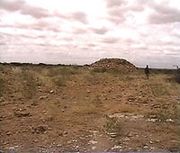Somali mythology facts for kids
Somali mythology is a collection of amazing stories. These stories include beliefs, myths, legends, and folk tales. They have been shared by the Somali people for thousands of years.
Many of these stories have changed over time. This happened especially after Islam came to the Horn of Africa. Even today, some old traditions are still important. For example, people still respect saints. Also, traditional Somali doctors and astronomers use ideas from ancient times. These old beliefs were once very strong in Somalia and the wider Horn of Africa.
Contents
Ancient Beliefs in Somalia
Before Islam arrived, the Somali people had a rich belief system. They believed in many gods, but one main, powerful god was above them all. This god was called Eebbe or Waaq.
Ancient religious temples were known as Taallo. These were special places where important ceremonies happened. A Wadaad priest would lead these events.
Waaq was a Sky God from before Islam. This god was linked to water, rain, and making things grow. Waaq also represented sacred trees, animals, nature, peace, and harmony. You can still hear Waaq's name in Somali words and places today. For example, Bar waaqo means "living happily." Towns like Ceel Waaq and clans like Cabu Waaq also carry the name.
Gods and Spirits
Here are some of the important gods and spirits from Somali mythology:
| Waaq (God) | Waaq was the main Sky God for many ancient Cushitic tribes. Somali nomads would pray to Waaq for rain. Words like Barwaaqo (meaning "living happily") come from Waaq. |
| Ayaanle (Angels) | The Ayaanle were good spirits in ancient Somalia. They were like messengers between God and humans. People believed they brought good luck and blessings. |
| Huur (Reaper) | Huur was the messenger of Death. This deity looked like a large bird. Huur had a role similar to Horus in ancient Egypt. |
| Nidar (Punisher) | Nidar was the one who made things right. This deity helped people who were treated unfairly. Even today, Somalis say, Nidar Ba Ku Heli, which means "Nidar will find and punish those who are naughty." |
| Wagar | Wagar was a special wooden sculpture. It was connected to making things grow and be fruitful. |
Famous Kings, Queens, and Heroes
Somali mythology is full of stories about brave men and women. These people became heroes or even saints among the Somali people.
| Amel Ali (Queen) | Amel Ali was a legendary queen from ancient Somalia. She was known as the fastest woman of her time. |
| Wiilwaal (King) | Wiil Waal was a legendary king in ancient Somalia. He was famous for his courage and fighting skills. |
| Bucur Bacayr (King) | Bucur Bacayr was a legendary king of the Yibir people in Somalia. |
| Arraweelo (Queen) | Queen Arraweelo was a legendary queen. She worked to give women more rights. She made men realize how much they needed women. |
Giants and Monsters
Somali mythology also tells tales of huge giants and scary demons.
| Habbad ina Kamas (Giant) | Habbad ina Kamas was a cruel giant. He ruled half of ancient Somalia. His rule was very unfair, unlike the kind rule of another giant, Biriir ina Barqo. Biriir eventually defeated and killed Habbad. |
| Biriir ina Barqo (Giant) | Biriir ina Barqo was a heroic giant in ancient Somalia. He was known for being fair and kind. He lived in a cave called Shimbiraale (the cave of birds). He wore a very heavy ring that no one else could lift. Biriir helped those suffering under Habbad's rule. He defeated Habbad and brought a long period of peace to the land. |
| Qori-ismaris ("One who rubs himself with a stick") | Qori-ismaris was a man who could turn into a "Hyena-man." He did this by rubbing himself with a magic stick at night. He could turn back into a human before dawn by doing the same thing. |
| Dhegdheer ("One with long ears") | Dhegdheer was a female demon who ate people. She hunted in Somali forests. Her victims were usually children who were lost or wandering. |
| Buuti (shape-shifting human/creature) | Buuti was one of Dhegdheer's children. She bravely saved innocent villagers, even though it put her own life at risk. She became a hero, but she was cursed to be a shape-shifting creature who ate people. |
| Fadumo iyo Farax (The surviving children of Buuti) | Fadumo iyo Farax were Buuti's children. They survived seven challenges and escaped their mother after finding out she killed their father and baby sibling. Fadumo and Farax lived alone until Fadumo got married and left. |
| Coowlay Jajab (continued story of Fadumo iyo Farax) | Farax grew old and wished for his sister to return. He prayed to be turned into a tree to wait for her. His prayer was answered, and he became a tree for many years. One day, his sister Fadumo returned with her family. Her children would cut leaves from the tree, and Farax would respond. When Fadumo realized it was her brother, she prayed to break the curse, and they were reunited. |
Mythological Places
Many places in Somalia have names that come from Somali mythology. The word Waaq itself is Somali and is used in names like Abudwaaq ("Worshiper of God") and Ceel Waaq ("Well of God"). These names show a connection to the old Waaq worship.
The Tomb of Arawelo is another famous mythological place in Somalia. It is said to be where Queen Arawelo was buried. Today, it is seen as an important place for Somali women.


